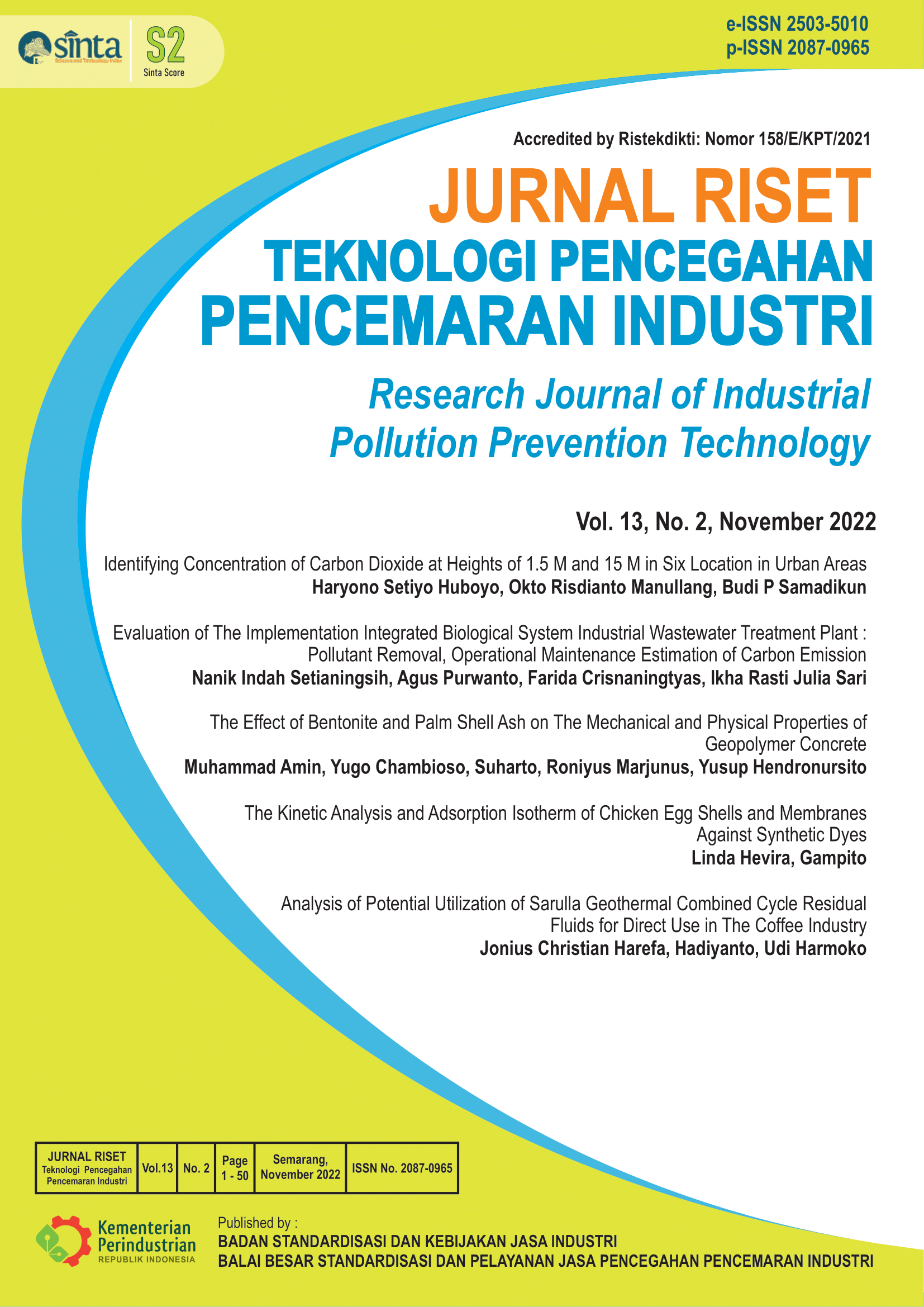The Effect of Bentonite and Palm Shell Ash on The Mechanical and Physical Properties of Geopolymer Concrete
DOI:
https://doi.org/10.21771/jrtppi.2022.v13.no2.p21-27Keywords:
Bentonite , Concrete, Compressive Strength, Geopolymer, Palm Shell AshAbstract
Geopolymer concrete is an alternative to obtaining environmentally friendly mortar by synthesizing materials that contain a lot of aluminum silicate. This study aims to determine the effect of bentonite and palm shell ash composition on geopolymers' physical and mechanical characteristics. All materials are mashed, mixed, and molded with a 5x5x5 cm3 cube. Ten specimens were prepared with bentonite - palm shell ash compositions are 40/45, 45/40, 50/35, 55/30, and 60/25 wt%. Meanwhile, the composition of NaOH, Na2SiO3, superplasticizer and water remained at 1.3, 7.7, 2, and 5 wt%, respectively. Then the samples were dried at room temperature for 24 hrs and heated at 60 °C or 80 °C for 12 hrs. The geopolymer concrete with the best characteristics was obtained with a composition of 40 wt% bentonites and 45 wt% palm shell ash by heating at 80 °C. This specimen has a compressive strength of 11.94 MPa with a density of 2.42 g/cm3, porosity of 8.43%, and absorption of 3.48%. The results have a chemical composition of 55.59% SiO₂, 9.45% Al2O3, and 8.22 Fe2O3 with a dominant quartz phase. Scanning electron microscope photo shows good bonding between particles, and there are no pores formed.References
Amin, M., & User, S. 2017. Pembuatan semen geopolimer ramah lingkungan berbahan baku mineral basal guna menuju lampung sejahtera. Inovasi Pembangunan: Jurnal Kelitbangan, 5(01), 30-45.
ASTM C20-00. 2015. “Standard Test Methods for Apparent Porosity, Water Absorption, Apparent Specific Gravity, and Bulk Density of Burned Refractory Brick and Shapes by Boiling Water.” ASTM International. https://doi.org/10.1520/C0020-00R10.2.
Davidovits, J. 1994. Global warming impact on the cement and aggregates industries. World resource review, 6(2), 263-278.
Duxson, P., Fernández-Jiménez, A., Provis, J. L., Lukey, G. C., Palomo, A., dan van Deventer, J. S. 2007. Geopolymer technology: the current state of the art. Journal of materials science, 42(9), 2917-2933.
Graille, J., Lozano, P., Pioch, D., dan Geneste, P. 1985. Essais d'alcoolyse d'huiles végétales avec des catalyseurs naturels pour la production de carburants diesels.
Islami, A. N., Saputra, E., dan Olivia, M. 2015. Kajian Parameter Mortar Geopolimer Menggunakan Campuran Abu Terbang (Fly Ash) dan Abu Sawit (Palm Oil Fuel Ash). In Prosiding 2nd Andalas Civil Engineering National Conference 160-167.
Jiminez, A. M. F., Lachowski, E. E., Palomo, A., & Macphee, D. E. 2004. Microstructural characterization of alkali-activated PFA matrices for waste immobilization. Cement and Concrete Composites, 26(8), 1001-1006.
Malau, F. B. 2014. Penelitian Kuat Tekan dan Berat Jenis Mortar Untuk Dinding Panel dengan Membandingkan Penggunaan Pasir Bengkulu dan Pasir Baturaja dengan Tambahan Foaming Agent dan Silica Fume. Jurnal Teknik Sipil dan Lingkungan. Jurusan Teknik Sipil Universitas Sriwijaya. 2 (2).
Mineral Commodity Summaries. 2014. US Department of the Interior US GeologicalSurvey.http://minerals.usgs.gov/minerals/pubs/mcs/2014/mcs2014/ (accessed 10. 03.21).
Mohd Ariffin, M. A., Hussin, M. W., dan Rafique Bhutta, M. A. 2011. Mix design and compressive strength of geopolymer concrete containing blended ash from agro-industrial wastes. In Advanced Materials Research (Vol. 339, 452-457). Trans Tech Publications Ltd.
Part, W. K., Ramli, M., dan Cheah, C. B. 2015. An overview on the influence of various factors on the properties of geopolymer concrete derived from industrial by-products. Construction and Building Materials, 77, 370-395.
Patankar, S. V., Jamkar, S. S., dan Ghugal, Y. M. 2013. Effect of water-to-geopolymer binder ratio on the production of fly ash based geopolymer concrete. Int. J. Adv. Technol. Civ. Eng, 2(1), 79-83.
Pavithra, P. E., Reddy, M. S., Dinakar, P., Rao, B. H., Satpathy, B. K., dan Mohanty, A. N. 2016. A mix design procedure for geopolymer concrete with fly ash. Journal of cleaner production, 133, 117-125.
Slaty, F., Khoury, H., Wastiels, J., dan Rahier, H. 2013. Characterization of alkali activated kaolinitic clay. Applied Clay Science, 75, 120-125.
Tangchirapat, W., Jaturapitakkul, C., dan Chindaprasirt, P. 2009. Use of palm oil fuel ash as a supplementary cementitious material for producing high-strength concrete. Construction and Building Materials, 23(7), 2641-2646.
Yang, Y., Jiang, J., Hou, L., Lu, Z., Li, J., & Wang, J. 2020. Pore structure and properties of porous geopolymer based on pre-swelled bentonite. Construction and Building Materials, 254, 119226.
Yusuf, M. O., Johari, M. A. M., Ahmad, Z. A., dan Maslehuddin, M. 2014. Strength and microstructure of alkali-activated binary blended binder containing palm oil fuel ash and ground blast-furnace slag. Construction and Building Materials, 52, 504-510.
Downloads
Published
How to Cite
Issue
Section
License
Copyright (c) 2022 Yusup Hendronursito, Muhammad Amin; Yugo Chambioso; Suharto, Roniyus Marjunus

This work is licensed under a Creative Commons Attribution-NonCommercial-ShareAlike 4.0 International License.











